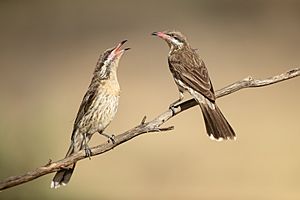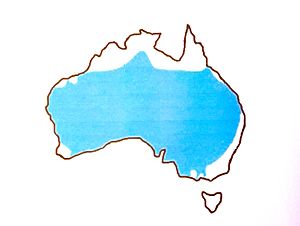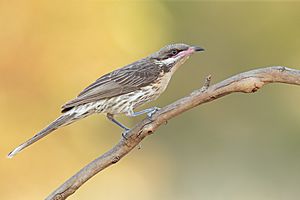Spiny-cheeked honeyeater facts for kids
Quick facts for kids Spiny-cheeked honeyeater |
|
|---|---|
 |
|
| Conservation status | |
| Scientific classification | |
| Genus: |
Acanthagenys
|
| Species: |
rufogularis
|
The spiny-cheeked honeyeater (Acanthagenys rufogularis) is a unique bird found only in Australia. It's the only type of bird in its group, called Acanthagenys. These birds are quite large for a honeyeater, growing to about 22 to 27 centimeters long. They usually weigh around 52 grams, which is about the same as a small apple.
Spiny-cheeked honeyeaters are friendly and often hang out in big groups. But they can also be a bit feisty! They mostly eat fruit, but they also enjoy sweet nectar from flowers, insects, and sometimes even small reptiles or young birds. You can find them in many places across Australia, like deserts, coastal areas, and dry forests. They also live in mangrove swamps and fruit orchards. They are not found in Tasmania, the far north, or the southeastern coast.
Contents
About the Spiny-cheeked Honeyeater
The scientific name for this bird is Acanthagenys rufogularis. The first part, Acanthagenys, comes from old Greek words meaning 'spine' or 'thorn' and 'cheek'. This refers to the spiny look of their cheeks. The second part, rufogularis, comes from Latin words meaning 'red' and 'throat'.
There are two main types, or "races," of this bird. One was identified by John Gould in 1838, and the other by K. C. Parkes in 1980. Both types live only in Australia.
What Does It Look Like?
The spiny-cheeked honeyeater is a medium-sized bird. It has a speckled, dark grey and brown head. Young birds have a bright yellow stripe on their cheek. As they get older, this stripe becomes less noticeable. Adult birds mostly have white cheeks with grey or brown streaks.
Their beak is long and straight. It has a black tip, but the part closer to their face is a fleshy red or pink. A dark stripe goes from their eyes back to their ears. Their chest is a creamy-white color with short, brownish streaks. Their throat is often light brown or cinnamon. Their wing feathers are a mix of dark olive-brown and grey with white edges. The tail feathers are similar, but with white tips. The feathers under their tail are white or light grey, sometimes with streaks.
The appearance of these birds can vary a bit. For example, spiny-cheeked honeyeaters living on the Mornington Peninsula in Victoria have darker bellies. Young birds also have brown eyes and paler skin around their beak.
Where They Live
You can find spiny-cheeked honeyeaters in most parts of Australia. However, they don't live east of the Great Dividing Range, in Tasmania, the far southwest of Western Australia, or in the tropical northern areas. They do live on Kangaroo Island in South Australia.
These birds are often seen in places with scattered trees or in areas with lots of spiky grasses like spinifex. These grasses are common in Australia's dry outback. In these areas, there might be a few small shrubs or trees where the birds can find shelter.
They also live in open woodlands, sparse shrublands, and even in managed farmlands with different types of grasses. Near the coast, like on the Mornington Peninsula, they can be found in tea-tree bushes along the shore. Sometimes, they visit mangroves and fruit orchards.
Spiny-cheeked honeyeaters are considered "nomadic" in northern Australia, meaning they move around a lot. But in the south, they tend to stay in one area and are considered "resident." They are a common bird across Australia.
Reproduction and Life Cycle
Spiny-cheeked honeyeaters can breed throughout the year. Eggs have been found from June to March. However, most eggs are laid between late August and mid-November in the eastern parts of Australia.
Female birds have been seen feeding newly hatched chicks with dark insect larvae in November and December. Later, in January, male birds were seen feeding fully grown young birds with red berries. Both parents work together to raise their young.
Nests usually contain two or three eggs. The eggs are off-white with dark brown speckles, mostly at one end. Nests are typically built from 1 to 13 meters off the ground, depending on where they can find a good spot. They are shaped like a deep cup or a hammock, woven with grass, spider silk, and spider egg sacs. The inside of the nest is often lined with soft materials, like possum fur or fluffy plant parts.
What They Eat and How They Help
Spiny-cheeked honeyeaters are very good at finding food. They are "opportunists," meaning they eat whatever is available. Studies show that about 38% of their diet is nectar from flowers. But they also eat insects, small lizards, spiders, and insect larvae.
Among honeyeaters in South Australia, the spiny-cheeked honeyeater has one of the largest beaks. They like both nectar and insects equally. When there's a lot of nectar available in winter and spring, they eat more of it. At other times of the year, they eat more insects. Since they also eat fruit, about 25% of their diet is fruit.
Birds have been seen eating fruit from native plants when feeding their young. They have also been seen in orchards, but it's not clear if they eat the orchard fruit often.
Honeyeaters, with their diet of nectar, insects, and fruit, help the environment in many ways:
- Pollination: When they drink nectar, they carry pollen from flower to flower. This helps plants make seeds and fruit.
- Seed Dispersal: After eating ripe fruit, they spread the seeds in their droppings. This helps new plants grow in different places, ensuring there's food for them and other animals. It also helps seeds avoid being eaten by animals that only eat seeds. Studies show that the seeds they spread are very likely to grow.
- Insect Control: While they might not completely control insect populations, studies have shown that when birds are removed from an area, there are more plant-eating insects, which can damage crops.
See also
 In Spanish: Mielero golicanelo para niños
In Spanish: Mielero golicanelo para niños




